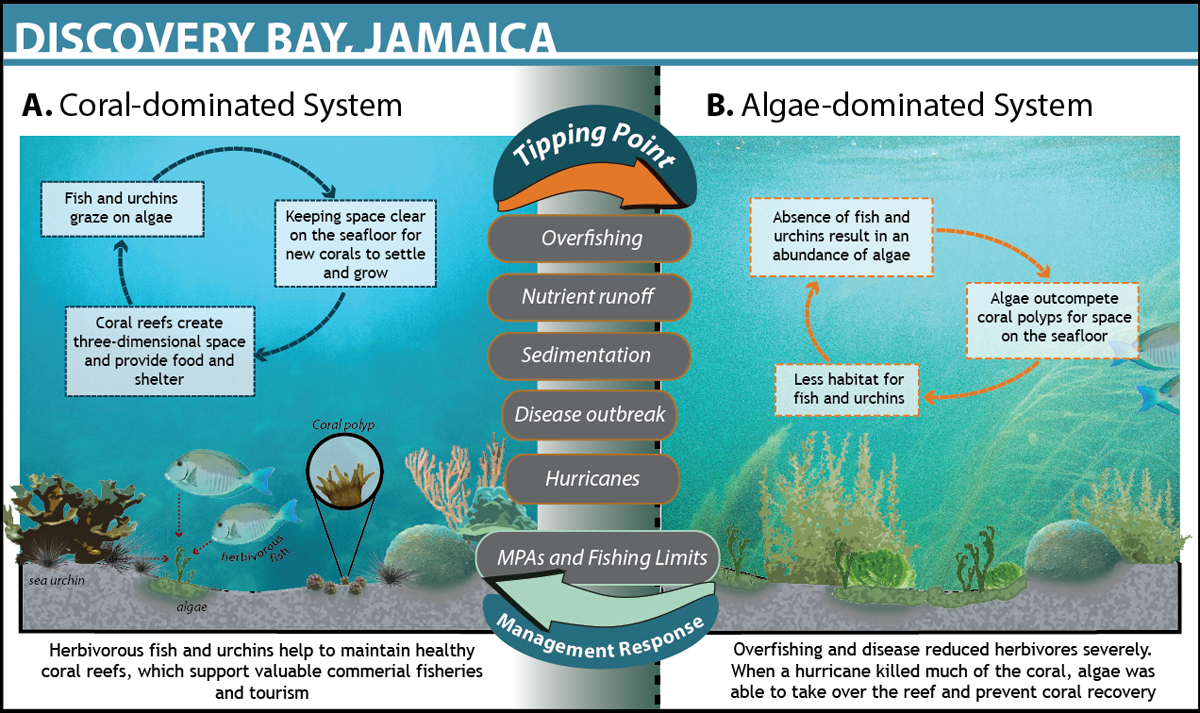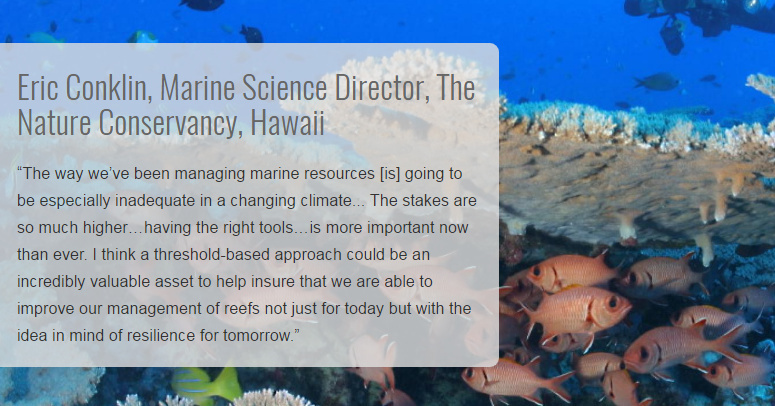Coral reef tipping points
Background
Researchers started to suspect tipping points in coral reef communities decades ago, beginning with the shifts from vibrant, diverse coral reefs to degraded reefs overrun with algae, observed in the Caribbean in the 1980s and 1990s. Long-term overfishing, especially of herbivorous fishes, and nutrient runoff eroded the resilience of coral-dominated ecosystems to recover from hurricanes and disease, and promoted the dominance of fleshy algae. By the turn of the century, it was clear that many Caribbean reefs had crossed a tipping point, and re-establishing healthy coral communities would be difficult, if not impossible, in our lifetimes.

Factors that can lead to a shift from a coral-dominated (left) to an algal-dominated ecosystem (right) and management strategies to protect and restore reefs, illustrated for Jamaican reefs. Ocean Tipping Points Project infographic, design by Jackie Mandoske.
The changes observed on Caribbean reefs in the 1980s proved to be the “canary in the coal mine,” with reefs across the world experiencing similar dramatic shifts as a result of rising local and global stressors, including land-based pollution, overfishing, and climate change. The number and variety of stressors that interact across the land-sea interface and across scales to affect reefs highlight the need for coordination across multiple agencies with different mandates, authorities and jurisdictions. Increasingly, communities and decisionmakers recognize the need to mitigate local stressors to enhance reef resilience in the face of global climate change. At risk is a suite of valuable benefits that coral reefs provide to coastal communities. Loss of coastal protection, fishing, tourism opportunities, and other benefits impact local economies, jobs and culture.

“The way we’ve been managing marine resources [is] going to be especially inadequate in a changing climate... The stakes are so much higher…having the right tools…is more important now than ever. I think a threshold-based approach could be an incredibly valuable asset to help insure that we are able to improve our management of reefs not just for today but with the idea in mind of resilience for tomorrow.”
-- Eric Conklin, Marine Science Director, The Nature Conservancy, Hawaii
Limited resources and time and a daunting array of both problems and potential management solutions result in a triage situation. Understanding the causes and warning signs of tipping points in coral reefs can help prioritize effective management actions and monitoring strategies and inform appropriate conservation and restoration targets1,2. Applying a tipping point approach is necessary but not sufficient: good governance is also critical3.
In the US, aspects of coral reef management fall under both state and federal management (as prescribed by the Magnuson Stevens Act, Clean Water Act, Coastal Zone Management Act, National Environmental Protection Act, Sanctuaries Act, Endangered Species Act, Coral Reef Conservation Act, and US Ocean Policy). In most if not all of these laws, there is scope for the application of ecological thresholds as reference points for reef health and for the use of scientifically informed strategies to address key land- and ocean-based drivers and build reef resilience.
We took a deep dive into tipping point science to see how it might enhance coral reef management in our Hawaii case study.
